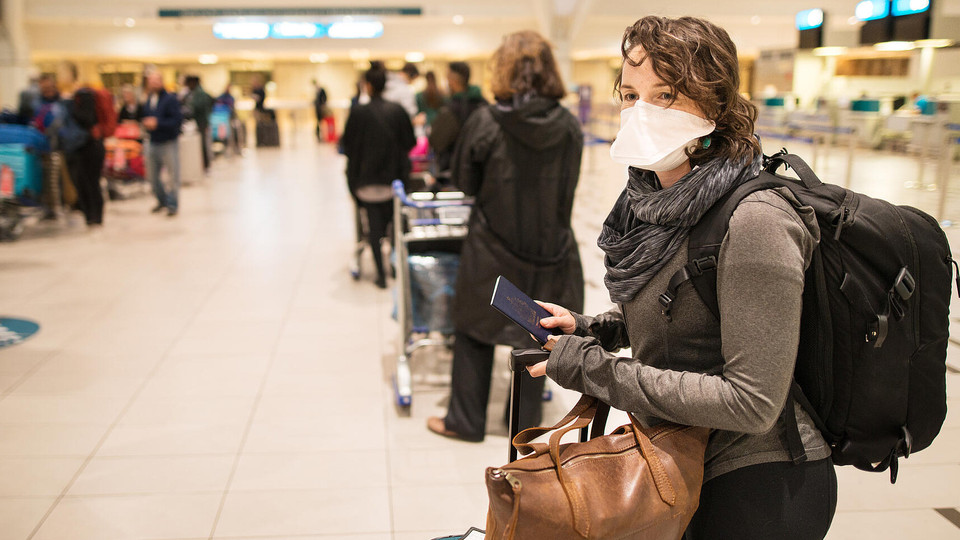Jun 23, 2020 Jan Uphues
ShareWoman waiting in a long line for a flight wearing a N95 face mask during a global pandemic
If you want to fly to Europe for your vacation in the next days and weeks, you probably need a thick skin. The conditions imposed by the authorities addressing airport operations will cause delays, long queues, and increased costs. Nevertheless, I predict that the numbers will increase – those of flights, those of passengers, and also those of seat load factors. For months, people in Europe have had to endure, in some cases, very tough lockdown measures. Today, the number of infections has decreased significantly, and the overall occurrence of infection is easier to monitor in most parts of Europe. It is therefore a logical step to lift the travel warnings. People within the EU should be able again to enjoy their freedom of movement, which would be a piece of long-awaited normality.
SECOND PART OF THE CRISIS
The first part of the corona crisis is now over. It was the part of the greatest uncertainties and even panic, in which our health care systems were heavily burdened and the occurrence of infection was what everyone was solely looking at for many weeks. The next phase is the very first part of the recovery for aviation, which will probably be slower to re-open and catch up than the rest of the economy. According to IATA, Air Travel may grow slower than most of economy and not regain 2019 levels before 2023 or even 2024 – depending on if we will have a global Corona setback or not. This new phase is characterized by several factors, especially for aviation. It is the recovery phase, which contains several major challenges and risks.
The first major factor is costs. Until a few months ago, it was all about achieving more efficiency that drove decisions in the aviation industry. Of course, money was very important, too – airlines are true masters at saving money – but it was even more important to use short slots in an increasingly time-efficient manner. More and more processes had to be coordinated in parallel, and with thin staffing levels, the available resources had to be optimally distributed within the field of task assignments. Today, it is no longer a question of a lack of resources. Aircraft, slots, parking positions, gates, staff, and equipment are available in abundance worldwide, depending on local and regional restrictions though. It’s true that the world airline index has rallied in the first half of June as travel demand is slowly returning. But in overall, in the first five months of the year, airline share prices in all regions were hit hard by the COVID-19 pandemic as global travel demand almost vanished. The world airline equity index lost almost half of its value over this period. So, there is a lack of money, passengers and, quite often, simply the opportunity to fly again. Especially long-haul flights are often simply not yet conducted due to remaining travel restrictions. This heavily impacts the business model of airlines and airports. They currently don’t have the entrepreneurial freedom that they and most other industries have been used to for decades.
Nevertheless, their focus is now on getting the business going again as quickly and as much as possible, while at the same time, costs must be saved. Finally, there is a need to pay back large loans that were used to bridge liquidity bottlenecks. To make matters worse, the seat load factor – probably the most important factor for profitability – is likely to remain below average for the coming weeks and months. This makes it all the more important during this period, when every penny must be counted, to make the planning processes deliver an optimal and reliable result.
ADJUSTED PLANNING NECESSARY
A situational adjusted planning is necessary as many new processes and safety precautions are being established at airports. In many respects, there is still much uncertainty about factors that can have a massive impact on planning. Let's take the small example of individual body temperature measurement of the passengers: When and by whom is it measured and evaluated? At the check-in? At boarding? Or even onboard? What is the procedure in case of signs of illness? Who is liable?
These factors bring an unprecedented level of complexity to the operation, making comprehensive planning even more necessary. For certain, additional resources are required – not only staff, but also time, equipment and even terminal resources.
Last but not least, it is also important to have enough passengers on board at least medium-term. Flights are only profitable with sufficient seat load factor. In order to achieve this, however, the airlines need to make passengers book flights again. It’s not only about ads that offer flights again for prospects. First and foremost, people need to trust again. Currently, six out of ten Germans don’t want to embark on an aircraft as they are afraid to get infected. It is essential to regain their trust and one of the most important confidence-building measures will be to implement clear, workable, and effective guidelines. Ultimately, also passengers will have to get used to the new Normal in aviation.
JOINT TASK AHEAD
Whichever way you look at it: airlines, airports, ground handlers and all suppliers have a Herculean task ahead of them. I’ve already used this term in a previous blog text a month or two ago. At that time I was only referring to the planning tasks. But the implementation of this planning, coupled with much stricter legal requirements, high costs, and volatile revenue prospects, make the business one of the most exciting ones at the moment – to put it positively. But, at least in terms of booking numbers of flights to classical tourist destinations all over Europe, there is definitely a silver lining. The booking numbers for the winter season and especially for the summer season are better than expected just a few weeks ago. They indicate a strong desire for the normal from the passengers’ side. This goes along with a pretty quick re-opening of all borders within Europe and, shortly after, presumably a re-opening to other countries (with this text being written mid-June).
Another slight comfort also lies in the fact that no airline and no airport is alone in this situation. It’s no-one’s fault, no company, no manager, and no employee has caused it by mismanagement or wrong assumptions. In the end, it’s a Black Swan Event that is very unlikely to occur ever again. For now, we’re in this together and we will sure get out of this together.
How do airlines cater to the cost-intensive restrictions, save money, generate turnover, and make new investments at the same time? Which investments are necessary for the new Normal in Aviation? Give us your opinion!
About our Expert

Jan Uphues
Marketing Manager
From the exhilarating rush of his very first flight, Jan Uphues was captivated by the world of aviation. Though that maiden voyage had its jittery moments, it set the course for a lifelong passion. Starting at INFORM in 2018, he combined it with his second love: crafting compelling content.


